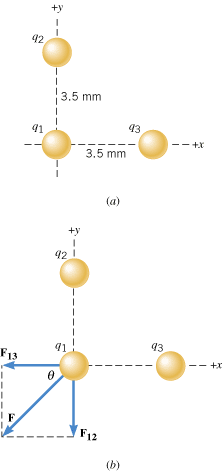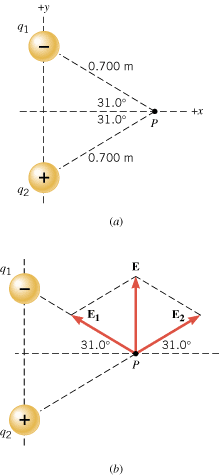|
The charges on three identical metal spheres are –12 mC, +4.0 mC, and +2.0 mC. The spheres are brought together so they simultaneously touch each other. They are then separated and placed on the x and y axes, as in Figure 18.40a. What is the net force (magnitude and direction) exerted on the sphere at the origin? Treat the spheres as if they were particles.
 | | Figure 18.40
(a) Three equal charges lie on the x and y axes. (b) The net force exerted on q
1 by the other two charges is F. |
|
Concept Questions and Answers Is the net charge on the system comprised of the three spheres the same before and after touching?
 | Answer
Yes. The conservation of electric charge states that, during any process, the net electric charge of an isolated system remains constant (is conserved). Therefore, the net charge on the three spheres before they touch (–12.0 mC + + 4.0 mC 4.0 mC + + 2.0 mC 2.0 mC = = –6.0 mC) is the same as the net charge after they touch. –6.0 mC) is the same as the net charge after they touch.
|
After the spheres touch and are separated, do they have identical charges?
 | Answer
Yes. Since the spheres are identical, the net charge (–6.0 mC) distributes itself equally over the three spheres. After they are separated, each has one-third of the net charge:  . .
|
Do q2 and q3 exert forces of equal magnitude on q1?
 | Answer
Yes. The charges q2 and q3 have equal magnitudes and are the same distance from q1. According to Coulomb’s law, then, they exert forces of equal magnitude on q1.
|
Is the magnitude of the net force exerted on q1 equal to 2F, where F is the magnitude of the force that either q2 or q3 exerts on q1?
 | Answer
No. Although the two forces that act on q1 have equal magnitudes, they have different directions. The forces are repulsive forces, since all of the charges in part a of the drawing are identical. Figure 18.40b shows the force F12 exerted on q1 by q2 and the force F13 exerted on q1 by q3. To obtain the net force F, we must take these directions into account by using vector addition.
|
Problem solving insight
Often charge magnitudes are specified in microcoulombs (mC). When using Coulomb’s law, be sure to convert microcoulombs into coulombs (1 m = = 10–6 C) before substituting for the charge magnitudes |q1| and |q2|. 10–6 C) before substituting for the charge magnitudes |q1| and |q2|. |
|
Solution
The magnitude F12 of the force exerted on q1 by q2 is given by Coulomb’s law, Equation 18.1, as
Note that we have used the magnitudes of q1 and q2 in Coulomb’s law. As mentioned previously, the magnitude of the force F13 exerted on q1 by q3 has the same value as F12, so F13 = = 2.9 2.9 × × 103 N. Since the forces F12 and F13 are perpendicular to each other, we may use the Pythagorean theorem to find the magnitude F of the net force:
The angle q that the net force makes with the –x axis (see part b of the drawing) is 103 N. Since the forces F12 and F13 are perpendicular to each other, we may use the Pythagorean theorem to find the magnitude F of the net force:
The angle q that the net force makes with the –x axis (see part b of the drawing) is
|

 .
.












